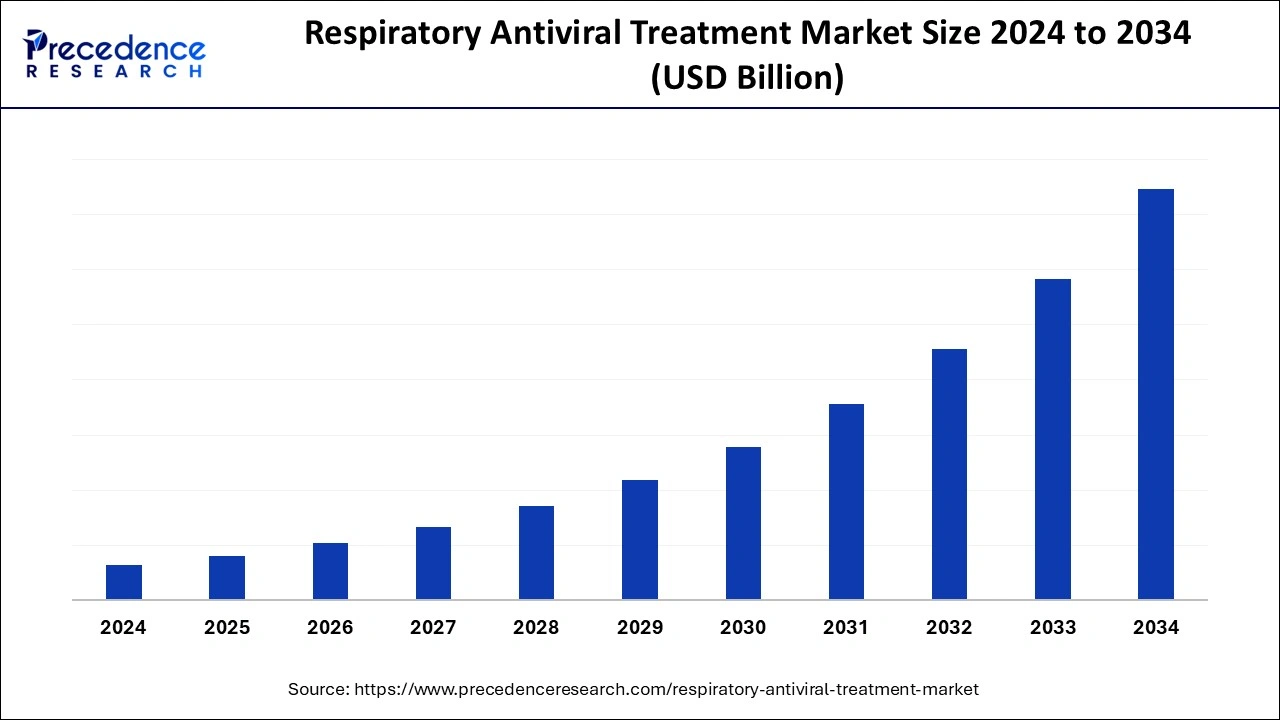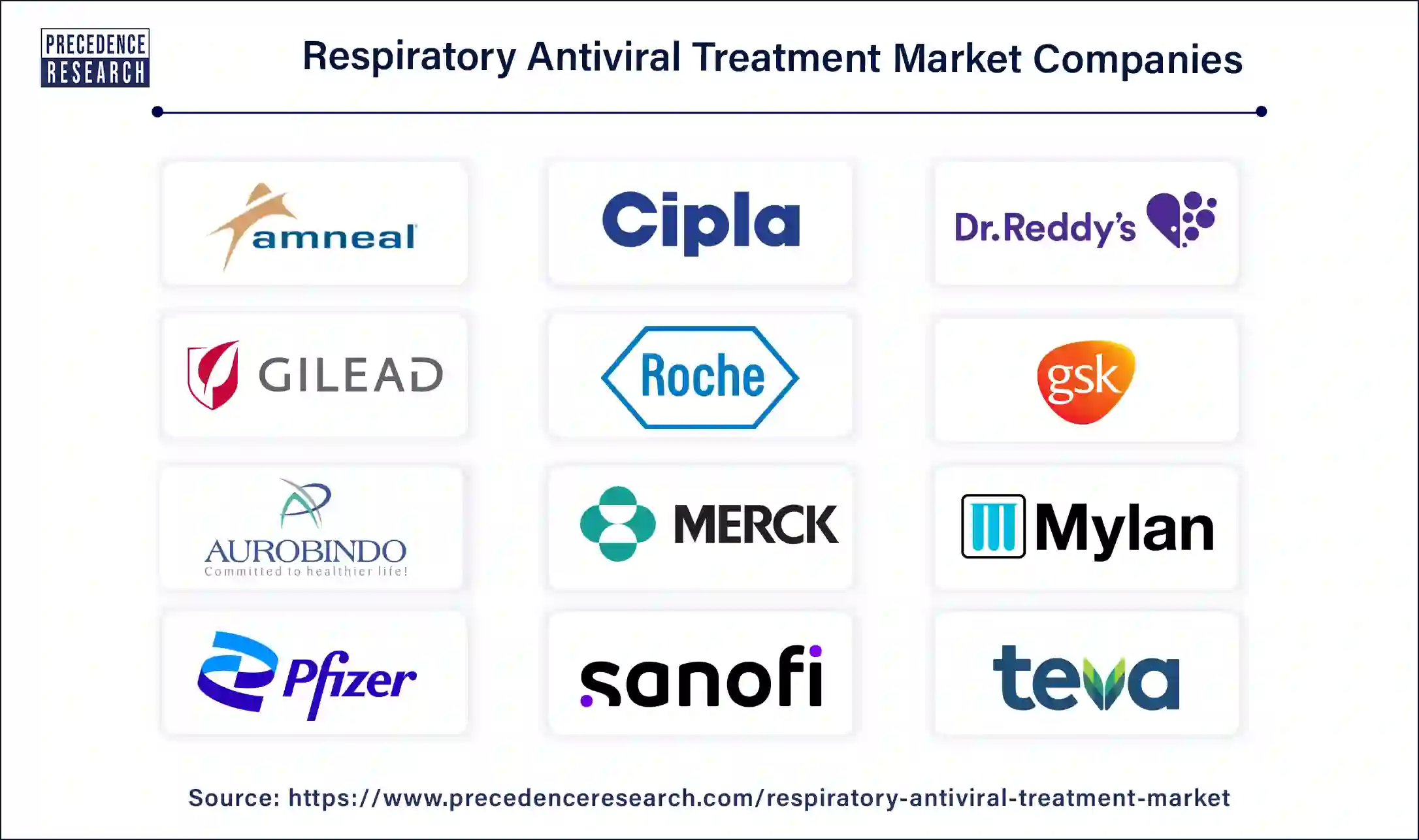February 2025
Respiratory Antiviral Treatment Market (By Disease Type: Pneumonia, Influenza, Bronchiolitis, Upper Respiratory Tract Infection, Others; By Drug Class: Nucleoside Analogs, Neuraminidase Inhibitors, Ion Channel Blockers, Fusion Protein Inhibitors; By Distribution Channel: Hospital Pharmacy, Retail Pharmacy, Online Pharmacy) - Global Industry Analysis, Size, Share, Growth, Trends, Regional Outlook, and Forecast 2025-2034
The global respiratory antiviral treatment market is surging, with an overall revenue growth expectation of hundreds of millions of dollars from 2025 to 2034. The rising prevalence of heart disease sector across the world is driving the growth of the respiratory antiviral treatment market.

Artificial intelligence is revolutionizing various industries, and the respiratory antiviral treatment industry is no exception. AI is making advancements in various types of respiratory antiviral treatment, providing potential for improved patient outcomes, personalized medicine, and faster drug discovery. To predict potential antiviral candidates, AI technologies can analyze a huge number of datasets of existing drugs, biological pathways, and molecular structures. AI can analyze patient data and enable personalized treatment plans, minimizing adverse effects and maximizing efficacy. In addition, AI holds the advanced ability to revolutionize the respiratory antiviral treatment market in the coming years.
The respiratory antiviral treatment market is one of the most important industries in the healthcare sector. This industry mainly deals in discovering, developing and manufacturing of antiviral therapies for treating respiratory problems. There are several types of antiviral drugs that mainly includes nucleoside analogs, neuraminidase inhibitors, ion channel blockers, fusion protein inhibitors and some others. These drugs are mainly distributed by a well-organised distribution channel including hospital pharmacy, retail pharmacy, online pharmacy and some other channels.
The technological developments related to medical industries along with rising government investment for strengthening healthcare sectors is likely to augment the market growth positively. This industry is expected to grow exponentially with the growth in the healthcare industry.
| Report Coverage | Details |
| Largest Market | North America |
| Base Year | 2024 |
| Forecast Period | 2025 to 2034 |
| Segments Covered | Disease Type, Drug Class, Distribution Channel, and Regions |
| Regions Covered | North America, Europe, Asia-Pacific, Latin America, and Middle East & Africa |
Rising prevalence of chronic obstructive pulmonary disease (COPD)
The respiratory diseases are considered as a leading of cause of death among the people of the world. Among respiratory diseases, the chronic obstructive pulmonary disease (COPD) has the highest prevalence across the world and caused maximum deaths worldwide. According to a data published in March 2023 by the WHO (World Health Organisation), the chronic obstructive pulmonary disease (COPD) was the 3rd leading cause of death around the world. This disease is generally caused by air pollution and tobacco smoking among others. Thus, the rising cases of COPD among patients increases the demand for antiviral drugs that are effective against COPD, thereby driving the growth of the respiratory antiviral treatment market. Also, several biopharma companies have started developing antiviral therapies for treating COPD, which is likely to boost the market growth.
High cost and side effects
The respiratory antiviral treatment industry has gained traction in recent times with the advances in drug development. Although, this industry is growing at a rapid pace but it faces several problems that impacts the market growth negatively. The cost of raw materials and wages of skilled workers in this industry is very high. Thus, in order to derive maximum profits, the manufacturers tend to increase the price of the finished product that restrains the market growth. Also, there are several side effects associated with respiratory antiviral treatments that mainly includes nausea, bronchospasm, diarrhoea, vomiting and some others, which in turn restrains the growth of the respiratory antiviral treatment market.
Integration of generative AI in antiviral drug delivery
The development in AI is an integral part for the development of antiviral therapeutics industry. The rising integration of generative AI in respiratory antiviral treatment has gained popularity in present times. With the use of generative AI, biopharma companies can develop superior quality antiviral therapeutics for treating several respiratory issues. Thus, rising integration of generative AI in antiviral drug manufacturing is expected to create ample growth opportunities for the market players in the future.
The neuraminidase inhibitors segment held the largest respiratory antiviral treatment market share in 2023. The growth of this segment is generally driven by the rise in advancement in medical sciences. Also, rising development in the biopharma sectors along with the increasing investments for research and development activities of antiviral drugs is expected to drive the market growth.
The growing prevalence of influenza among the people across the world has increased the demand for neuraminidase inhibitors as neuraminidase inhibitors are effective for treating influenza disease. Thereby, driving the market growth. The main types of neuraminidase inhibitors in the market includes zanamivir, oseltamivir and some others. Moreover, several biotechnology companies are developing antiviral therapeutics and constantly engaged in conducting clinical trials of these medicines for treating respiratory diseases, that in turn drives the growth of the respiratory antiviral treatment market.
The nucleoside analogs segment is expected to be the fastest growing segment during the forecast period. The growth of this segment is generally driven by the growing cases of COVID-19 in some parts of the world. Also, growing initiatives of private sector entities for developing high-quality antiviral drugs for treatment of respiratory disorders boosts the growth of the respiratory antiviral treatment market.
The rise in number of research and innovation centres for developing antiviral drugs along with growing applications of pyrimidine inhibitors for treating SARS-CoV-2 infection drives the market growth. The most widely used nucleoside analogs includes acyclovir, ribavirin and some others, Moreover, nucleoside analogs are found effective against arthropod-borne flaviviruses that in turn is expected to boost the market growth.
The influenza segment dominated the market in 2024. The growth of this segment is generally driven by the rising prevalence of H1N1 flu among the people across the world. Also, the growing demand for oseltamivir phosphate to treat acute influenza among infants is likely to boost the market growth. The rising cases of flu across the world increases the demand for antiviral therapeutics that boosts the growth of the respiratory antiviral treatment market during the forecast period. According to CDC (Centers for Disease Control and Prevention), around 27 to 54 million flu cases along with 19,000 - 58,000 deaths in the U.S during 2022 and 2023. Moreover, the biopharma companies are constantly engaged in developing high-grade antiviral medicines for treating influenza virus that is likely to drive the market growth.
The pneumonia segment is expected to grow at a notable rate during the forecast period. The growth of this segment is driven by the rising prevalence of pneumonia among the across the world. Also, rising demand for acyclovir for treating pneumonia patients is also expected to drive the market growth. Moreover, the rise in number of public hospitals with pneumonia treatment specialities is likely to propel the growth of the respiratory treatment market during the forecast period.
The hospital pharmacy segment held the largest market share in the respiratory antiviral treatment market. The growth of this segment is generally driven by the rising developments in hospital infrastructure. Also, the rise in the government investments for developing modern hospitals with integrated pharmacies drives the market growth. Moreover, the availability of antiviral drugs for treatment of several respiratory diseases such as flu, influenza, COPD and some others in hospital pharmacies is likely to boost the growth of the respiratory antiviral treatment market.
The retail pharmacy segment is expected to be the significnatly growing segment during the forecast period. The growth of this segment is generally driven by the rise in number of retail pharmacies in different parts of the world. Also, the growing number of retail pharmacy chains across the world boosts the market growth. Moreover, rising development in the supply chain of pharmaceutical products along with increase in government initiatives for strengthening the retail pharmacy sector is expected to drive the growth of the respiratory antiviral treatment market.
North America held the largest respiratory antiviral treatment market share in 2024 and is expected to maintain its dominance throughout the forecast period. The growth of this region is mainly driven by the rising government initiatives in countries such as the U.S., Canada, Mexico and some others for strengthening the healthcare sector. The growing developments in the healthcare industry along with the presence of well-established biotechnology sector drives the market growth. Also, the rising advancements in science and technology along with the establishment of several drug research institutions and innovation centres is likely to drive the market growth.
Moreover, presence of several market players such as Johnson & Johnson Private Limited, Abbvie, Gilead Sciences, Inc., Pfizer, Merck & Co., Inc. and some others are constantly engaged in developing high-quality respiratory antiviral medicines and adopting several strategies such as launches, collaborations and acquisitions, which in turn drives the growth of the respiratory antiviral treatment market in this region.
Asia Pacific is expected to be the fastest growing region during the forecast period. The growth is mainly driven by the rising prevalence of pneumonia among the children in this region. According to the UNICEF (United Nations International Children's Emergency Fund) data, around 2500 children in per 100 children suffers from pneumonia in South Asia. Also, rising investments by public and private sector entities for developing the antiviral drugs sector is boosting the market growth. The growing incidences of influenza diseases in this region increases the demand for antiviral drugs for getting cured. Additionally, the rise in number of government hospitals with high quality doctors along with adequate pharmacy facilities has driven the market growth in this region.
Moreover, rise in government initiatives for strengthening the medical sector along with presence of several biopharma companies such as Teva Pharmaceuticals, Zydus Cadila, Dr. Reddy's Laboratories Ltd and some others are constantly engaged in developing respiratory antiviral medicines and adopting several strategies such as launches, partnerships and expansions, which is likely to drive the growth of the higher education market in this region.

By Disease Type
By Drug Class
By Distribution Channel
By Geography
For inquiries regarding discounts, bulk purchases, or customization requests, please contact us at sales@precedenceresearch.com
No cookie-cutter, only authentic analysis – take the 1st step to become a Precedence Research client
February 2025
August 2024
January 2025
January 2025